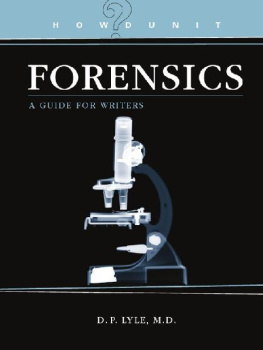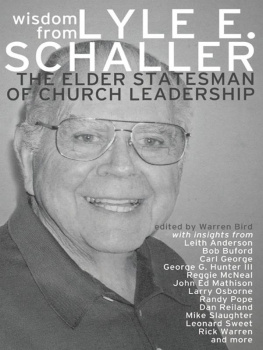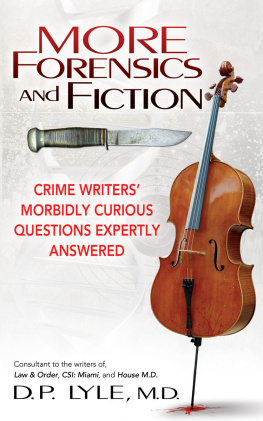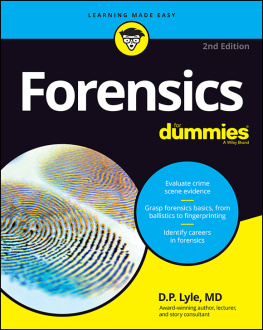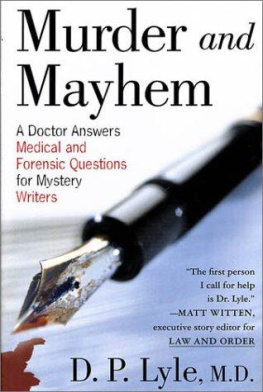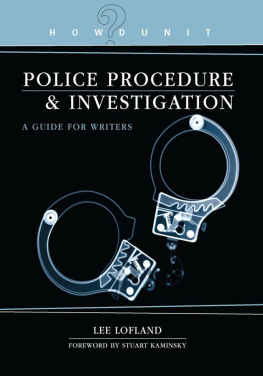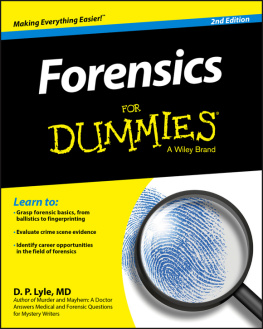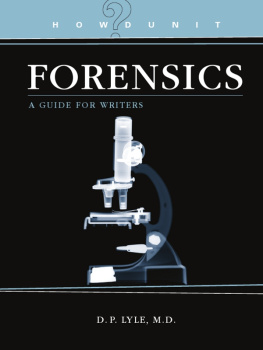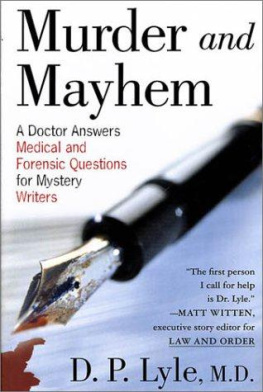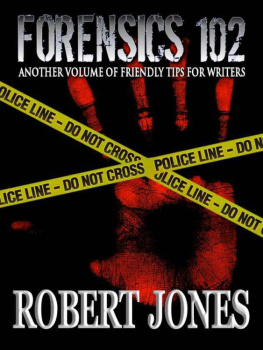D. P. Lyle - Howdunit Forensics: a guide for writers
Here you can read online D. P. Lyle - Howdunit Forensics: a guide for writers full text of the book (entire story) in english for free. Download pdf and epub, get meaning, cover and reviews about this ebook. year: 2008, publisher: F+W Media, genre: Romance novel. Description of the work, (preface) as well as reviews are available. Best literature library LitArk.com created for fans of good reading and offers a wide selection of genres:
Romance novel
Science fiction
Adventure
Detective
Science
History
Home and family
Prose
Art
Politics
Computer
Non-fiction
Religion
Business
Children
Humor
Choose a favorite category and find really read worthwhile books. Enjoy immersion in the world of imagination, feel the emotions of the characters or learn something new for yourself, make an fascinating discovery.
- Book:Howdunit Forensics: a guide for writers
- Author:
- Publisher:F+W Media
- Genre:
- Year:2008
- Rating:3 / 5
- Favourites:Add to favourites
- Your mark:
- 60
- 1
- 2
- 3
- 4
- 5
Howdunit Forensics: a guide for writers: summary, description and annotation
We offer to read an annotation, description, summary or preface (depends on what the author of the book "Howdunit Forensics: a guide for writers" wrote himself). If you haven't found the necessary information about the book — write in the comments, we will try to find it.
D. P. Lyle: author's other books
Who wrote Howdunit Forensics: a guide for writers? Find out the surname, the name of the author of the book and a list of all author's works by series.
Howdunit Forensics: a guide for writers — read online for free the complete book (whole text) full work
Below is the text of the book, divided by pages. System saving the place of the last page read, allows you to conveniently read the book "Howdunit Forensics: a guide for writers" online for free, without having to search again every time where you left off. Put a bookmark, and you can go to the page where you finished reading at any time.
Font size:
Interval:
Bookmark:

HOW ? DUNIT
FORENSICS
A GUIDE FOR WRITERS
D.P. LYLE, M.D.

WRITER'S DIGEST BOOKS
www.writersdigest.com
Cincinnati, Ohio
Forensics 2008 by D.P. Lyle. Manufactured in Canada. All rights reserved. No part of this book may be reproduced in any form or by any electronic or mechanical means including information storage and retrieval systems without permission in writing from the publisher, except by a reviewer, who may quote brief passages in a review. Published by Writers Digest Books, an imprint of F+W Publications, Inc., 4700 East Galbraith Road, Cincinnati, Ohio 45236. (800) 289-0963. First edition.
Visit our Web sites at www.writersdigest.com and www.wdeditors.com for information on more resources for writers.
To receive a free weekly e-mail newsletter delivering tips and updates about writing and about Writers Digest products, register directly at our Web site at http://newsletters.fwpublications.com.
12 11 10 09 08 5 4 3 2 1
Distributed in Canada by Fraser Direct, 100 Armstrong Avenue, Georgetown, ON, Canada L7G 5S4, Tel: (905) 877-4411; Distributed in the U.K. and Europe by David & Charles, Brunel House, Newton Abbot, Devon, TQ12 4PU, England, Tel: (+44) 1626 323200, Fax: (+44) 1626 323319, E-mail: postmaster@davidandcharles.co.uk; Distributed in Australia by Capricorn Link, P.O. Box 704, Windsor, NSW 2756 Australia, Tel: (02) 4577-3555
Library of Congress Cataloging-in-Publication Data
Lyle, D. P.
Forensics : a guide for writers / by D.P. Lyle.
p. cm. -- (Howdunit)
ISBN 978-1-58297-474-3 (pbk. : alk. paper)
1. Forensic sciences--Popular works. 2. Criminal investigation. 3. Fiction--Authorship--Handbooks, manuals, etc. 4. Criminal investigation in literature. I. Title.
HV8073.L93 2008
363.25--dc22
2007029114
Edited by Michelle Ehrhard
Designed by Claudean Wheeler
Production coordinated by Mark Griffin

DEDICATION
This book is dedicated to all the clever writers who work to get it right. I hope this book will help them do just that.
ABOUT THE AUTHOR
D.P. Lyle, M.D. is the Macavity Award-winning and Edgar Award-nominated author of the nonfiction books, Murder and Mayhem , Forensics for Dummies , and Forensics and Fiction, as well as the thrillers, Devils Playground and Double Blind .
He has worked as a story and technical consultant with many published authors and with the writers and producers of several popular television shows, including Law & Order, CSI: Miami, Diagnosis Murder, Monk, Judging Amy, Cold Case, Peacemakers, House, Medium, and 1-800-Missing .
Through his Web site, The Writers Medical and Forensics Lab (www.dplylemd.com), he works with writers and readers to enrich their understanding of complex medical and forensic issues in the stories they write and read.
He was born and raised in Huntsville, Alabama, where his childhood interests revolved around football, baseball, and building rockets in his backyard. The latter pursuit was common in Huntsville during the 1950s and 60s due to the nearby NASA/Marshall Space Flight Center.
After leaving Huntsville, he attended college and medical school, and served an internship at the University of Alabama; followed by a residency in Internal Medicine at the University of Texas at Houston; then a Fellowship in Cardiology at The Texas Heart Institute, also in Houston. For the past thirty years, he has practiced cardiology in Orange County, California.
TABLE OF
CONTENTS
BY MATT WITTEN
BY LEE GOLDBERG
FOREWORD
BY MATT WITTEN
W riting crime novels and TV shows is a lot of fun, but there are definitely occupational hazards. For one thing, you tend to have rather odd dreams. Also, your family can get a tad perturbed when you discuss serial killers or methods of strangulation at the dinner table. And last but not least, you can find yourself in the middle of writing a great murder mystery and suddenly realize you have no idea what the hell youre talking about.
Reading Howdunit: Forensics may not cure your dreams or make you a more socially appropriate dinner partner, but it will definitely make you feel more knowledgeable. Even better, youll actually be more knowledgeable. This book covers all of the forensics basics, from DNA to gunshot residue to associated legal issues, in a comprehensive way.
Not only that, this book is extremely readable with highly entertaining anecdotes. In fact, my biggest problem with the book is that when I was reading it, my wife kept sneaking it away from me so she could read it. And shes not even into this stuff.
In my work on Law & Order, Womens Murder Club , and other crime shows, I have consulted a lot of experts and read a lot of reference books. I have found that most scientists dont think like crime writers. Doug Lyle actually does, no doubt because hes been helping crime writers for over a decade and has answered hundreds upon hundreds of our questions. Howdunit: Forensics is absolutely the best reference for crime writers I have ever seen.
Best of all, you will probably find that reading this book inspires you to think up new ideas for murder mysteries and plot twists. In fact, Im thinking of a way to work Lyles story about The Shark Arm Murder into my next TV episode. Maybe Ill try it out on my family at dinner.
MATT WITTEN has written for several television crime shows including Law & Order, CSI: Miami, Womens Murder Club , and Homicide . He also wrote the Jacob Burns mystery novels for Signet.
FOREWORD
BY LEE GOLDBERG
W hen I started out writing TV cop shows, I was taught to avoid the science stuff, the boring exposition that kills the momentum of a good story. Whatever the science was, and there shouldnt be too much of it, you could quickly throw away in a line. You could have one of your cops say the lab found trace evidence at the crime scene that leads directly to Doug Lyle, and off wed go to the next car chase, gunfight, or cat-and-mouse game of wits.
The only show I can remember that even showed a passing interest in science was Hawaii Five-O . In each episode you could count on blue-suited, lantern-jawed Steve McGarrett going down to see Che Fong who, in his white lab coat, would dryly spout useless exposition based on, at best, questionable science. It was so silly that every Naked Gun movie couldnt resist spoofing it.
Nobody wanted science in their cop shows. They wanted good-looking heroes, fast-moving stories, quirky characters, and great action.
Did Columbo ever talk to a crime scene investigator? Hell no.
Did Jessica Fletcher ever consult a lab report? Get real.
How often did the cops of Hill Street Blues , Homicide , or NYPD Blue go down to the lab for a briefing? Almost never. They were too busy dealing with their complicated sex lives, their substance abuse problems, the bureaucracy of the legal system, and the political machinations within their police departments.
Why werent the TV writers behind those shows paying attention to forensics? Because it was exposition which, by definition, isnt exciting. We believed that viewers didnt care about physical evidence; they cared about people, they cared about passion, they cared about action. They were interested in whodunit, and whydunit, not particularly howdunit.
There simply wasnt anything sexy, thrilling, or suspenseful about test tubes, fingerprints, bodily fluids, DNA, pubic hairs, and autopsies.
Or so it seemed.
Next pageFont size:
Interval:
Bookmark:
Similar books «Howdunit Forensics: a guide for writers»
Look at similar books to Howdunit Forensics: a guide for writers. We have selected literature similar in name and meaning in the hope of providing readers with more options to find new, interesting, not yet read works.
Discussion, reviews of the book Howdunit Forensics: a guide for writers and just readers' own opinions. Leave your comments, write what you think about the work, its meaning or the main characters. Specify what exactly you liked and what you didn't like, and why you think so.

